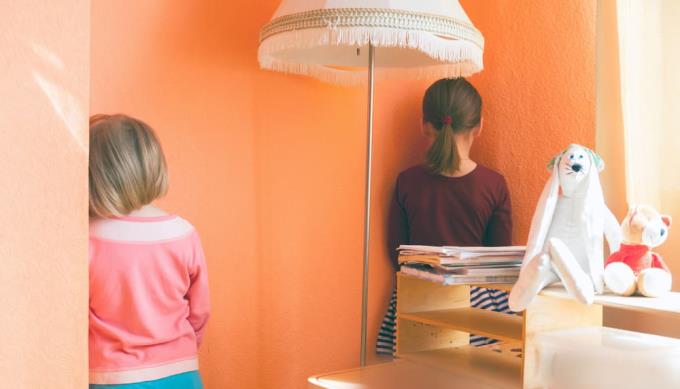Ways to determine an infants caloric needs

Learn how to determine your baby’s caloric needs, including the calories in breast milk and formula, to ensure your infant gets the right nutrition for healthy growth.
The time-out penalty is a light punishment, a form of separating the child from a situation where the child is annoying. The application of this punishment is intended to help children become calm, properly aware of their behaviors and remember what people want from them.
In this article, aFamilyToday Health provides you with more useful information around this whip-free teaching method, application methods and common answers.
Time-out is a whip-free teaching method, the purpose of which is to separate children from annoying situations. This helps children calm down, think about what they have done and learn by themselves so that they do not continue making mistakes. You can apply this method to children aged 3–5 years , when they begin to have a basic sense of right and wrong.
In fact, the penalty for face-to-wall punishment, penalty of kneeling or standing penalty in the corner of the house that many Vietnamese families are applying is similar to the time-out penalty.
While being punished, the baby is not allowed to talk to anyone, not to do anything including going to the toilet or drinking water. Time-out is like a form of short-term isolating children, meaning that if you make a mistake, your child will be punished and not played with anyone, including toys .
When applying time-out or whip-free parenting, you have to be very patient because this teaching method takes a lot of time. According to some parents, this spanking-free teaching method is very helpful in correcting the child's inappropriate behaviors.
When imposing a time-out penalty on your child, you should:

If the child harasses, you should not punish the child immediately, but warn and warn him in advance that if this behavior continues, he will be punished. If after 2 times of deterrence, the child still continues, please strictly announce: the child must be fined and put the child in the prescribed place. If you give a warning and your baby knows how to stop at the right time, don't hesitate to praise him.
If your child apologizes or cries after you have declared the child subject to a penalty, you should not accept it. Strictly ask the child to take the punishment.
Time to be punished should be in minutes, each year corresponds to 1 minute of penalty. You should use a countdown timer to keep track of your baby's fine time. If the penalty period expires, the child repeats the old behavior, you need to make it clear to your child that you do not accept this improper behavior and punish him again from the beginning.
Note that the number of penalties per day should not be too much (about 20 times), which will affect the child's psychology.
During the punishment time, if the baby voluntarily leaves the position or tries to attract attention, you should just keep quiet and be strict, bring the child to the penalty spot and start the timer.
The position to execute the time-out penalty should be chosen where as few people pass by as possible, with no toys, comics, television, no outside windows, no close proximity to the pet 's sleeping area ... Boring children with this position and being forced to think about what is prompted to adjust the behavior accordingly.
If you are in a public place, you need to take your child to a place with few people to punish them but don't forget to keep an eye on them.

When the punishment time is over, you need to talk to your baby to clarify why the child is being punished, how to not be punished next time, ask the child why he or she is disturbed ...
Do not forget to praise if after the punishment time, the baby has positive actions or attitudes.
In fact, while applying this whip-free parenting method, many parents encounter bad situations, crying and laughing. Here are the common scenarios and their solutions:
1. The child screams and cries during the time-out and even after the penalty has ended, what should I do?
According to many parents sharing that the child cries when being punished, even when the punishment time is over, parents should apply the technique of "eating butter cake, wearing a hat" with that child's action. . Because normally, every child will cry when punished and this is a normal psychological state of young children. So, depending on the ability to control and experience the punishment, some children will stop right after, but some children will persistently cry.
In fact, many babies stop crying after a few realizations that they don't have any positive results, parents don't care at all. In case the baby still cries when the penalty time is over, you should not continue to punish the baby, let him know that next time if he is punished, he can only get out of the penalty position if he stops crying and obeys. .
2. What should parents do if a child asks to go to the toilet or drink water while time-out?
According to the CDC pediatric expert, USA: The fact is that the time-out is quite short, so you do not need to pay attention to the needs and personal activities of the child. If you compromise your child to go to the bathroom or go to the toilet while being fined, he or she will know to "take advantage of" this in the next few times or try to get out of the punishment ahead of time.
In the event that your child really needs to go to the toilet, you should tell them that the time will be stopped and after the toilet is finished, the penalty will continue until the end.
3. When the child voluntarily leaves the sanctioned position, what should parents do?
You should strictly remind your baby to return to the sanctioned position and stay there until the end of the time, don't forget to let them know what will happen if they don't listen. This helps your baby think and make choices, thereby helping his cognitive ability to develop.
When making this law, you must follow the law. This helps children learn the lesson of making choices and taking responsibility for it.
4. There are two young children in the family, often fighting over toys or joking around, how should parents behave?

According to many parenting psychologists, in this case, you should determine which child is the "first" of the fight and apply time-out punishment on that child. In addition, you should consider "punishing" the toy - the agent of the war - in a certain time, so that the child cannot play anymore.
If both children contribute to the "fight" or you cannot determine which child triggers the "fight", you can consider punishing both and "punishing" the toy, do not forget to tell your child why. The time a toy is timed out is the average of the ages of the two children. Then, tell your child why toys are also punished and that they should share toys in a reasonable and harmonious way when they play together.
5. Children harassing in public, how should I find a time-out area to punish the child?
It is not uncommon for children to harass public places by crying, pleading, screaming ... In this case, find a corner with few people passing by and tell your child that you will count from 1 to 3, if the child does not stop, he will be punished. When counting, count slowly so that your child has time to adjust his or her emotions so that they can adjust their behavior accordingly. If the child still disobeys, you should apply the time-out penalty.
If you want to apply the time-out punishment to teach your child and correct the child's harassing behaviors, be very patient. Time is the ultimate therapy to help solve many problems, right?
Learn how to determine your baby’s caloric needs, including the calories in breast milk and formula, to ensure your infant gets the right nutrition for healthy growth.
Discover the top 5 smartest dog breeds in the world, including Border Collie, Poodle, German Shepherd, Golden Retriever, and Doberman Pinscher. Learn about their unique traits and why they are considered the most intelligent dogs.
Discover 7 nutritious and delicious ways to cook egg porridge for babies, including recipes with cheese, pumpkin, tomato, and more. Learn how to prepare baby-friendly egg porridge with our expert tips.
After a series of medical measures they obtained a complete human vascular system profile.
Watermelon is one of the fruits that many people love, not only cheap but also delicious, nutritious and refreshing in the summer. To get delicious watermelon pieces, show off your housewives, your artistic talents to cut beautiful pieces of watermelon.
aFamilyToday Health - The digestive system and body in each baby is different. Parents need to recognize notes to deal with when babies have a food allergy!
Babies need many factors for perfect development. aFamilyToday Health shares with parents things to keep in mind when babies are 8 weeks old so that parents can take care of their babies the best!
Babies need many factors for perfect development. aFamilyToday Health shares with parents things to keep in mind when babies are 18 weeks so that parents can take care of their babies the best!
Babies need many factors for perfect development. aFamilyToday Health shares with parents things to keep in mind when babies are 28 weeks old so that parents can take care of their babies the best!
Babies need many factors for perfect development. aFamilyToday Health shares with parents things to keep in mind when babies are 32 weeks old so that parents can take care of their babies the best!








